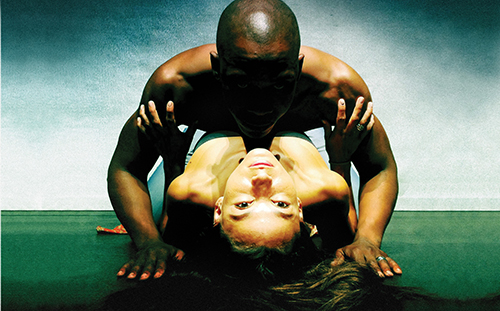
It’s Freedom Day for the black farm workers of Veenen Plaas (Dutch for ‘Weeping Farm’) in the Karoo region of South Africa. Hot and arid, the farm kitchen, with its red tiled floor and rows of dirty boots, forms a backdrop upon which the action unfurls. Despite the post-apartheid setting, it quickly becomes apparent that Yael Farber’s take on Strindberg’s classic Miss Julie sits upon a tight coil of prejudice, misunderstanding, envy and hatred – all about to be unleashed.
This production is visceral and raw, with scantily-clad and sexually-charged Julie, played by Hilda Cronje, pinching and prancing around the nonchalant John, manservant to Julie’s farm-owning father. John, captured perfectly by Bongile Mantsai, quickly becomes aggressive as Julie’s playful provocations progress to slaps and snarls. The jeering and taunting relentlessly spirals towards the – excuse the pun – climax of the play, and what follows is horrible beyond belief.
This production is brave and bold. Yael Farber leaves absolutely nothing to the imagination
This production is brave and bold. Yael Farber leaves absolutely nothing to the imagination; all inner sadness, hurt and betrayal, feelings of displacement and abandonment by both land and ancestors, rears its ugly head, violently shaking John, Julie and the audience at the very core.
Yet there is little empathy to be found; the audience is more shocked than moved, and the characters more bloodied than bettered. Thoko Ntshinga as Christine, John’s mother, provides the only sense of groundedness in Mies Julie, preferring the real roots which attach her to the land to the ensuing principles of heritage and ownership that are debated and defiled by John and Julie.
A dark, earthy score undercuts each scene, with live singing and music to evoke the ancestral heritage of the land, and a variety of languages are used interchangeably to again capture the multicultural nature of the Karoo region. Visually stunning, a bird cage floats behind the scene, hinting at the impossibility of escape, and shadows and smoke are used by set and lighting designer Patrick Curtis to sully the landscape, provoking sombre feelings of distrust.
Whilst a hard-hitting piece of story-telling, the constant circling and verbal contradictions are apt to leave one slightly dizzy (does she love him? Does she not? Does it matter?), and language is laboured and doggedly pursued. Yet the cloying effect this has perfectly matches the juxtaposition of two worlds, a tense tirade of emotions which can only end in tragedy.
**** (4 stars)
Until 19th May
More info
Be the first to comment